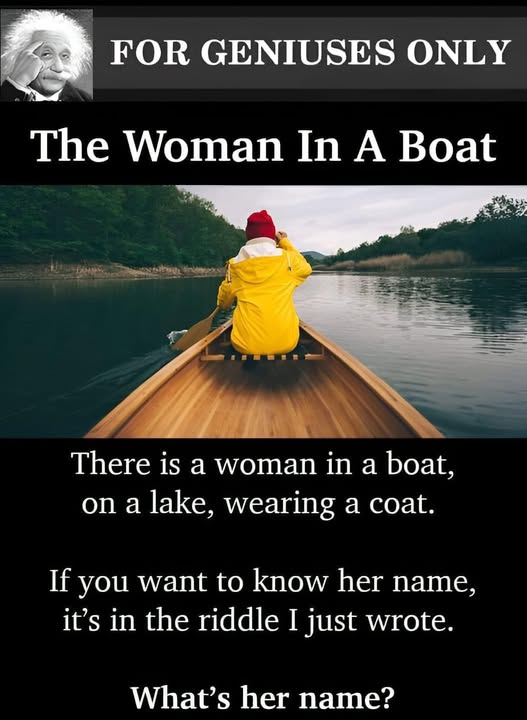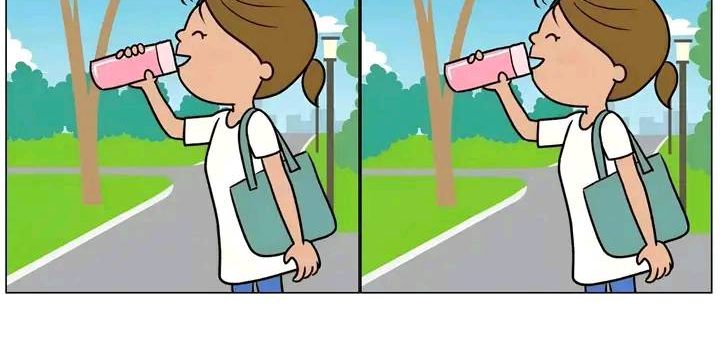In today’s digital world, where entertainment is instantly accessible and endless, it’s easy to forget how a simple riddle can still challenge the mind and spark curiosity in the most unexpected ways. Among countless videos, games, and social media posts, a clever riddle recently went viral for its ability to stump even experienced puzzle lovers. Called “The Woman in a Boat” riddle, this brain teaser isn’t about complicated math or logic. Instead, it plays with words and your ability to interpret language literally, forcing you to shift your perspective and think differently. Ready to take a crack at it? Here’s how it goes: “There is a woman in a boat, on a lake, wearing a coat.

If you want to know her name, it’s in the riddle I just wrote.” That’s it. At first glance, it might seem like just a rhyming sentence with a simple structure, but it’s actually a brilliant example of how wordplay can mess with your expectations. The challenge isn’t about reading between the lines; it’s about reading the line exactly as it is. The riddle says the woman’s name is right there in the riddle—literally. So what’s her name? The answer is “There.” That’s right—“There is a woman in a boat…” It might seem silly or even confusing at first, since “There” isn’t a conventional name. But that’s what makes this riddle so clever.
It flips your thinking, leading you to overcomplicate the solution when the answer is right in front of you. Many people waste time searching for metaphors or hidden meanings, but the key is simply taking the words at face value. If this riddle got your gears turning, you’ll love a couple more that follow a similar pattern—simple on the surface, but tricky once you start second-guessing yourself. Try this one: “Mr. Smith had four daughters. Each of his daughters had a brother.
How many children does Mr. Smith have?” It sounds easy, right? But this question trips up plenty of people. Most assume each daughter has a different brother, leading them to guess eight children total. But the riddle doesn’t say each daughter had a different brother—it just says they each had a brother. That means all four daughters share the same one brother. So the real answer is five children: four daughters and one son. It’s a subtle twist that teaches you not to make assumptions based on wording that seems familiar. Now for another fun one that uses sound to fool you: “I met a man on London Bridge. He tipped his hat and drew his name. He cheated at the guessing game. What was the man’s name?” This might sound like a riddle about a mysterious stranger or some poetic concept.
But pay attention to the second line: “he tipped his hat and drew his name.” When spoken aloud, “and drew his name” sounds exactly like “Andrew is his name.” That’s the answer—Andrew. It’s a play on phonetics, and it highlights how sometimes the solution isn’t something you see, but something you hear. These kinds of riddles are so satisfying because they disrupt the way we typically understand language. We’re used to looking for complex answers, so when a riddle delivers the solution right up front, our brains often miss it. These puzzles are simple, clever, and endlessly entertaining—not because they’re hard in the traditional sense, but because they challenge our usual ways of thinking. You don’t need a degree in logic or a background in puzzles to enjoy them. All it takes is a moment of focus, a little creativity, and a willingness to look at language from a different angle. So, did you manage to guess the woman’s name, the number of Mr. Smith’s kids, and the name of the man on the bridge without peeking at the answers? Whether you nailed them or needed a hint, the real fun is in the process of solving them. Share these riddles with your friends and family, see who figures them out first, and enjoy the laughs along the way. One thing’s for sure—when it comes to riddles like these, thinking outside the box is the name of the game.





